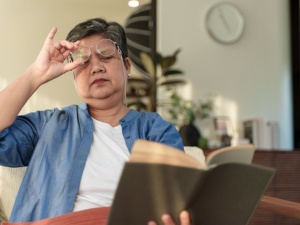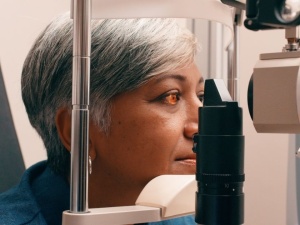Reading is an essential part of daily life for many, from scanning through emails to indulging in exciting novels. You might benefit from reading glasses if you struggle with this activity or other near-vision tasks. Unlike conventional prescription glasses, they only enhance the clarity of objects close to the wearer, such as printed text and digital screens. This eyewear is also helpful for people with presbyopia, a common age-related vision condition.

In this post, a local optician helps you determine if you need reading glasses.
What Are Reading Glasses?

Presbyopia is a normal part of aging. It’s when your eyes slowly lose their ability to focus on nearby objects. This condition makes it difficult to read small print or focus on detailed work up close. It often occurs around the mid-40s and progresses until the late 50s.
If you have presbyopia, reading glasses may become your trusted companion. These glasses come with magnified lenses, enlarging what’s in your field of view. You can use them when reading print materials, sewing or viewing digital screens.
Moreover, reading glasses don’t correct nearsightedness, farsightedness or astigmatism. You can think of them as a magnifying glass that helps you read. If you have a refractive error, you must see an optometrist and get prescription eyewear.
Do You Need Reading Glasses?

You’re Holding Objects Further Away
Do you need to extend your arms when reading a book or using your phone? These are signs your near vision is compromised. This behavior is usually an unconscious attempt to bring text into focus. The eye’s natural lens hardens and loses flexibility as presbyopia progresses, making it difficult to focus on nearby objects. By holding items further away from you, you’re trying to compensate for this loss of focus.
You’re Experiencing Frequent Headaches
Spending hours reading or doing close-up work can strain your eyes. Fatigue and discomfort are consequences of overworked eye muscles. The more your eyes struggle to focus, the higher the likelihood of tension headaches. These headaches often occur around the forehead and temples and may worsen if you don’t give your eyes a break.
Wearing reading glasses can help alleviate eye strain, providing a more relaxed visual experience. It’s best to schedule an eye exam if you still struggle to see clearly or your headaches persist. After performing a series of tests, your eye doctor can tell if you need prescription glasses or other treatments. 
You Have Blurred Vision
Blurred vision is a common symptom of presbyopia. If you have this eye condition, your eyes won’t be able to adjust their focus as effortlessly as they once did. Reading small text on medicine bottles, menus or smartphone screens might become more challenging. You might find yourself needing more light to see clearly. However, increasing lighting is only a short-term solution. It might be more comfortable to wear glasses.
You’re Suffering From Eye Fatigue
Experiencing tired eyes, especially after close-up work, is another symptom of presbyopia. Eye fatigue or asthenopia can manifest as a feeling of heaviness in the eyes. It happens when the eyes work too hard to focus on nearby objects. Individuals who have it might have difficulty keeping their eyes open. Some might feel a dry or burning sensation in their eyes.
Over time, eye fatigue can make it challenging to perform activities that require prolonged close-up focus, such as reading, sewing or using a computer. Reading glasses can help reduce eye strain and discomfort.
You Keep Squinting
Constant squinting is a clear indication that your near vision needs correction. When you squint, your eyes slightly change shape and won’t allow as much light to enter, temporarily improving vision. Unfortunately, squinting for extended periods can result in eye strain and even wrinkles around the eyes. If you catch yourself squinting to see clearly, don’t wait long before getting an eye examination.
What Are the Different Types of Reading Glasses?

Not all reading glasses are made equal. You can get them in different magnification strengths. The diopters or strength of lenses you need may depend on your age and habits. For instance, older individuals usually need stronger lenses.
Reading glasses are also available in different types to cater to various needs and preferences. These include:
Single Vision Glasses
The lenses of magnified reading glasses have uniform magnification. You might prefer them if you only need reading glasses for specific tasks.
Bifocal Reading Glasses
The lenses of bifocal reading glasses have two zones. The upper area lets you see far objects, while the lower part helps you view things up close. Specialists often recommend them to people 40 and older with presbyopia.
Progressive Reading Glasses
Presbyopia patients can also benefit from progressive reading glasses. This type of eyewear has three different magnification levels. Progressive lenses allow you to see clearly at all distances. Their top part aids distance vision, the middle area helps you see things at arm’s length, and the bottom section is designed for up-close tasks.
Polarized Reading Sunglasses
Do you often go outdoors or love going to the beach? Polarized sunglasses can protect your eyes from the sun’s glare while helping you see clearly.
Why Regular Comprehensive Eye Exams Matter

Routine comprehensive eye exams can do more than determine if you need reading or prescription glasses. They are essential to the early detection of vision-threatening eye problems. Many of these conditions don’t show symptoms in their initial stages, including glaucoma and macular degeneration.
Did you know your eye doctor can also catch signs of serious health problems during your appointment? High blood pressure, diabetes, cancers and autoimmune diseases are some conditions detected through an eye exam. While examining your eyes, your doctor might see changes in blood vessels and blood supply in your retina, which can indicate different health issues.


Leave a Reply